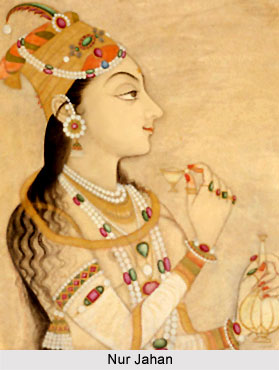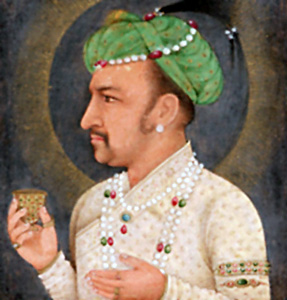 Nur Jahan was the daughter of Mirza Ghiyas Beg who belonged to a noble family of Tehran. She was earlier known as Mehr-un-nisa. Mihr-un-nisa got married to Jahangir in the year 1611 A.D. and was given the title of Nur Mahal and Nur Jahan respectively by Jahangir afterwards.
Nur Jahan was the daughter of Mirza Ghiyas Beg who belonged to a noble family of Tehran. She was earlier known as Mehr-un-nisa. Mihr-un-nisa got married to Jahangir in the year 1611 A.D. and was given the title of Nur Mahal and Nur Jahan respectively by Jahangir afterwards.
Early Life of Nur Jahan
Mirza Ghiyas Beg worked under the service of Akbar and being a talented person he soon rose to eminence. He was appointed as the Diwan at Kabul and later on became Diwan of the emperor`s household. In 1594 A.D., Mehr-un-nisa was married to Ali Quli Beg. In 1599 A.D. Ali Quli Beg was given the title of Sher Afghan by Jahangir when he killed a tiger single-handedly. When Jahangir ascended the throne, he appointed Sher Afghan as the Jagirdar of Burdwan in Bengal but he was eventually killed in a combat with Qutub-ud-din, the governor of Bengal. Mehr-un-nisa was appointed in the service of Salima Begum, the widow of Akbar, and it was there that Jahangir fell in love with her and eventually married her.
Influence of Nur Jahan on Mughal Politics
Nur Jahan increased her influence right from the time of her marriage with the emperor. In 1613 A.D. she was elevated to the rank Badshah Begum or the first lady of the realm. Her relatives were also promoted to higher ranks. She started appearing with the emperor in Jharokha Darshan; her name was engraved on some of the coins. Thus, practically the administration was taken over by Nur Jahan and no important decision concerning the state could be taken without her consent. Jahangir, who was gradually becoming accustomed to her owing to age and indifferent health, was also not reluctant to delegate his authority to his intelligent and hardworking queen.
 Nur Jahan`s political career may be divided into two period. The first, from 1611 to 1622 A.D.,when her father and mother were alive and kept a sobering influence on her ambitions. The second period was that of 1622-1627 A.D. when Jahangir gave her more liberty to control the administration due to his ill-health during this period. That resulted in her ambition of capturing the power of the throne in her hands even in case of death of her husband and consequently came in conflict with Shah Jahan. Soon after her marriage, Nur Jahan formed a clique of her own called Nur Jahan Junta. Each member of this clique was capable and occupied high offices in the state. Nur Jahan remained supreme in administration till 1622 A.D. with the help of these powerful members of her clique.
Nur Jahan`s political career may be divided into two period. The first, from 1611 to 1622 A.D.,when her father and mother were alive and kept a sobering influence on her ambitions. The second period was that of 1622-1627 A.D. when Jahangir gave her more liberty to control the administration due to his ill-health during this period. That resulted in her ambition of capturing the power of the throne in her hands even in case of death of her husband and consequently came in conflict with Shah Jahan. Soon after her marriage, Nur Jahan formed a clique of her own called Nur Jahan Junta. Each member of this clique was capable and occupied high offices in the state. Nur Jahan remained supreme in administration till 1622 A.D. with the help of these powerful members of her clique.
Revolts Under Nur Jahan
In 1621 A.D., Ladli Begum, Nur Jahan`s daughter by Sher Afghan, was married to prince Shahryar. Nur Jahan desired to keep the power of the state in her hands even after the death of her husband. Therefore, Nur Jahan planned to put Shahryar on the throne after the death of Jahangir. This resulted in the revolt of Shah Jahan and resulted in the weakening of the empire in his later years of reign. Mahabat Khan also revolted in 1626 A.D. and tried to finish the influence of Nur Jahan in the state. Mahabat Khan was loyal to the throne but was among those nobles who did not like the increasing influence of Nur Jahan in the state. Nur Jahan knew it and therefore, she put a check on his promotions though he was one of the ablest commanders of Jahangir. It resulted in the revolt of Mahabat Khan and he succeeded in capturing the person of the emperor. Thus, the interference of Nur Jahan in the politics of the state resulted in two major rebellions during the last years of the reign of Jahangir which weakened the empire and harmed its prestige. If Nur Jahan would not have been interested in accession of her son-in-law, Shahryar to the throne, the revolt of Shah Jahan would not have occurred and there was no question of the revolt of Mahabat Khan. Thus the interference of Nur Jahan proved harmful to the empire.
When Nur Jahan married Jahangir, she was thirty-four years of age. She was extremely beautiful even at that age. Besides, she was an educated, intelligent and cultured lady and was fond of poetry, music and painting. She wrote verses in Persian. She had an inventive brain and devised new dresses, ornaments and styles of fashion and decoration. She was interested in administration and had the capacity to tackle the relevant problems. She was courageous, patient, social, generous, religious and friend of the poor and oppressed. Nur Jahan was highly ambitious as well. She participated in administration, interfered in the politics of her time, increased her influence and tried to keep the power of the state in her hands. Therefore, she influenced the history and politics of her time.



















